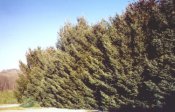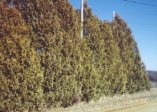Kevin Kelly with the award he received from the Support Iowa farmer organization to set up the program to establish vegetative buffers around livestock facilities through out the Midwest. We have done work to establish vegetative buffers for livestock buildings in Missouri, Illinois, Indiana, Kansas, Nebraska, Ohio Minnesota, North Carolina, and Iowa. Support Iowas Farmers has named KTF as a provider of advice and plant material, for people who want to do a buffer planting around any type of livestock facility.
Vegetative buffers control odors through five distinct mechanisms:
Lifting and mixing. Vegetative buffers lift the odorous air and dilute the odor compounds with fresher, less odorous air.
Settling. Some odorous compounds leave the livestock facility attached to dust particles. The slower wind speed caused by the lower levels of the vegetative buffer offer the ideal environment for these heavier particles to settle out of the air stream.
Filtering. Odor compounds and dust particles attach to the leaf surfaces of the vegetative buffer as the odorous air travels through the vegetation.
Breakdown of odorous particles. Bacteria living on leaf surfaces metabolize the attached odorous compounds.
Aesthetics. Trees distract a person’s eye and tend to soften the view of the livestock facility giving the site a more pleasing assessment and therefore the odor may seem less offensive.
Below three pictures is what we can do for you in 3 years.
Above is a hog building in Iowa just before we planted it.
We used 2 rows of potted austrees 5 Ft tall spaced 8 ft apart in the row and 8 ft. between rows. We are looking south in this picture. Go Right >
Above is the result after 2 years, they are about 16 ft tall, and are already catching lots of blowing snow coming into the area.
Above, after 3 years of growth, we have trees about 25 ft tall, they are now catching all the snow and providing some real windbreak protection even in the winter. The building has now "disappeared" from the neighbors if this is what you want and odors now are having to pass threw the trees, slowing their progression into the landscape.
Above is a row of Austrees only 45 ft from the hog building which is too close if you have several blizzards, as the snow can drift right on the roof and cause problems. Above is one 12"snowfall with 40 MPH winds did this, think what would happen if we got several more snowstorms. Austree work great as a snow fence but keep outside row at least 80 ft from building, 100 ft is better for snow control.
The picture above is of Ryan Reed (left) of Ottumwa, Iowa, and his tree planting around his hog buildings that we helped design and supplied the trees for. With their planting of trees and other things Ryan and Lana have done they were awarded the 2012 Pork Industry Environmental Stewards award. Click on the right link to see pictures, article and video on what they have done to deserve this honor of a pork producer. Aerial picture shown right.









